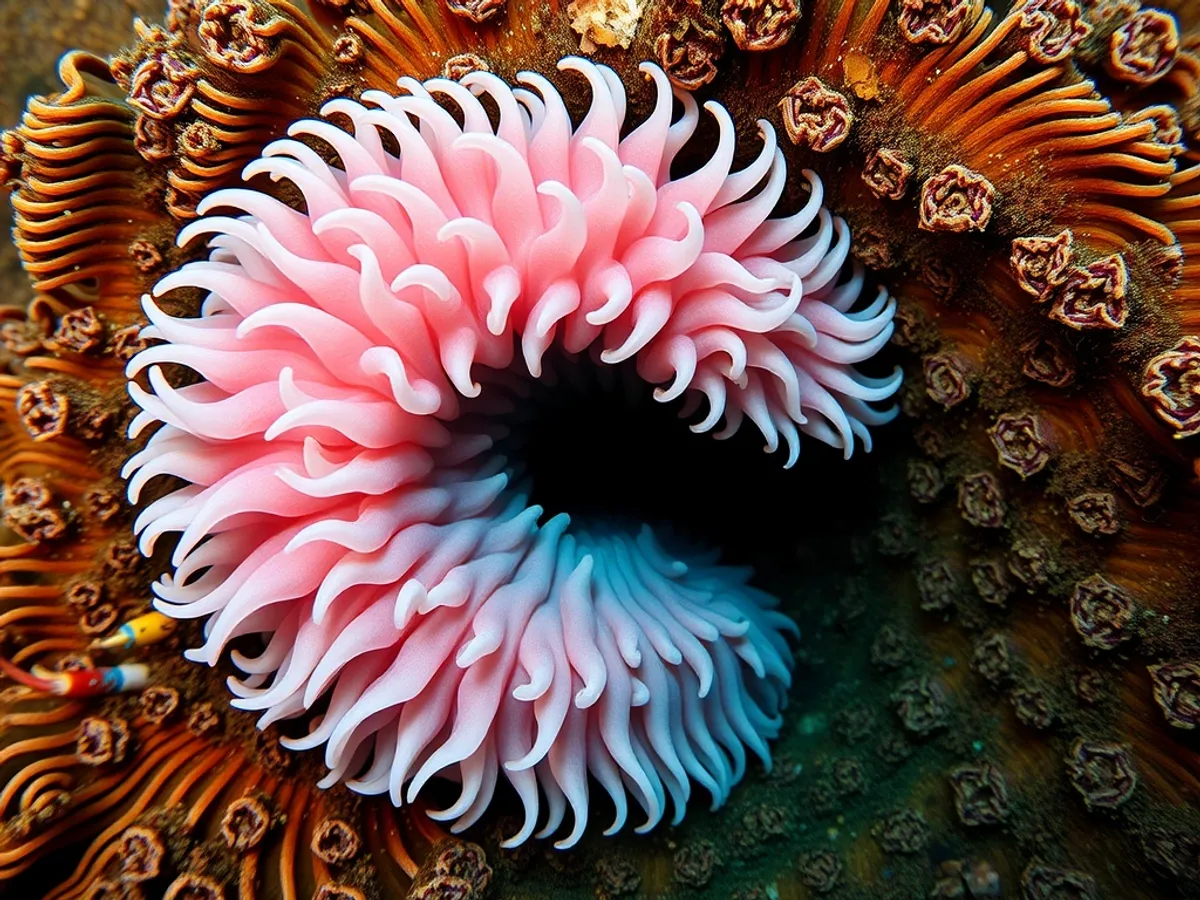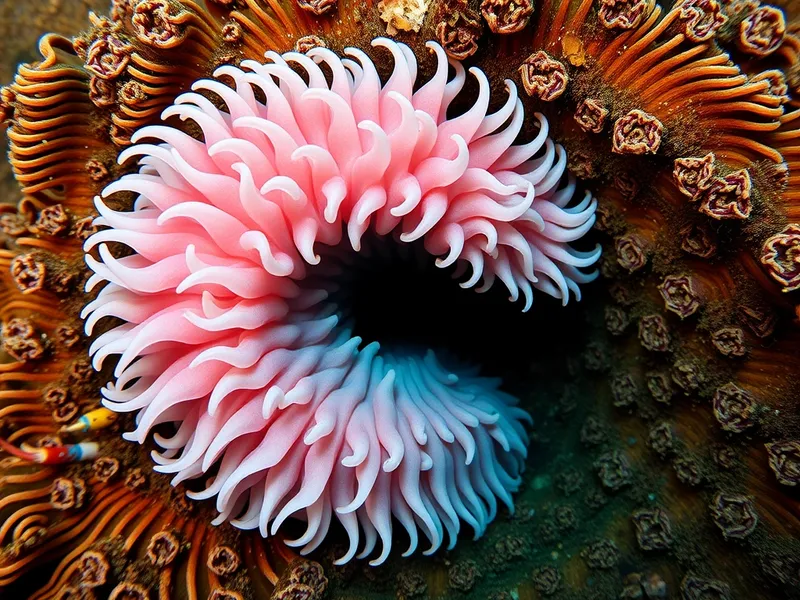
Giant Tube Worm
Riftia pachyptila

Meet the Giant Tube Worm
The Giant Tube Worm is a remarkable deep-sea invertebrate found near hydrothermal vents along the ocean floor, notably in the East Pacific Rise. Growing up to 2.4 meters (8 feet) in length, these worms live inside white chitinous tubes and lack a traditional digestive system. Instead, they rely on a symbiotic relationship with chemosynthetic bacteria living inside their body, which convert toxic vent chemicals into nutrients. This adaptation allows them to thrive in complete darkness and under tremendous pressure where few other multicellular organisms can survive.
Classification
Invertebrate
Habitat
Deep-sea hydrothermal vent
Diet
Chemosynthetic symbiosis
Lifespan
1-3 years
Conservation
Least Concern
Weight
0.1–0.2 kg
📖Fascinating Facts
Vent Dwellers
Giant Tube Worms live exclusively around deep-sea hydrothermal vents, where superheated water rich in minerals flows from the seafloor.
Symbiotic Partners
They rely on chemosynthetic bacteria inside their bodies to process hydrogen sulfide from vent water into usable organic molecules.
Red Plumes
Their bright red plumes are packed with hemoglobin, which helps transport both oxygen and hydrogen sulfide to their symbiotic bacteria.
📋Detailed Description
The Giant Tube Worm (Riftia pachyptila) is a large annelid endemic to deep-sea hydrothermal vent ecosystems, particularly along the East Pacific Rise and the Galápagos Rift. Adults can reach lengths of up to 2.4 meters (8 feet) and diameters of 4-5 cm, making them among the largest known polychaete worms. Their bodies are encased in a tough, white, chitinous tube, which provides protection from predators and the harsh vent environment. The worm's anatomy is highly specialized: it lacks a mouth, gut, and anus in its adult form, relying entirely on a unique organ called the trophosome, which houses dense populations of chemosynthetic bacteria. These bacteria oxidize hydrogen sulfide from vent fluids, producing organic molecules that nourish the worm. The anterior end features a bright red plume, rich in hemoglobin, which facilitates the uptake of oxygen, carbon dioxide, and hydrogen sulfide from the surrounding water. Riftia pachyptila exhibits rapid growth rates, with juveniles reaching full size in less than two years, an adaptation to the often ephemeral nature of hydrothermal vents. The worms form dense aggregations, sometimes numbering thousands of individuals per square meter, creating complex biogenic habitats that support diverse vent communities. Their presence is critical for the structure and function of vent ecosystems, offering substrate and shelter for numerous associated species. Despite the extreme conditions—high pressure, complete darkness, and toxic chemicals—Riftia displays remarkable physiological and biochemical adaptations for life at the ocean's abyssal depths.
💡 Did you know?
Giant Tube Worms were unknown to science until 1977, when hydrothermal vents and their unique ecosystems were first discovered.
🔬Research & Sources
🎭Behavior & Social Structure
Giant Tube Worms are sessile as adults, permanently anchored within their tubes, and exhibit minimal movement. They do not actively hunt or graze; instead, their feeding is entirely dependent on the passive diffusion of vent fluids across their plume, which is periodically extended from the tube to maximize exposure to dissolved gases. The worms retract their plumes rapidly in response to physical disturbance or changes in water chemistry, a defensive behavior against predators such as vent crabs and fish. Socially, Riftia pachyptila forms dense colonies, which may facilitate larval settlement and enhance local chemical gradients, but there is no evidence of cooperative or antagonistic interactions among individuals. Daily routines are dictated by vent fluid chemistry and flow, with plume extension and retraction modulated by environmental cues. The worms are a keystone species, providing habitat complexity and influencing nutrient cycling within the vent ecosystem.
👶Reproduction & Life Cycle
Riftia pachyptila is dioecious, with separate male and female individuals. Reproduction is believed to occur year-round, as hydrothermal vents lack pronounced seasonal cycles. Gametes are released into the water column, where external fertilization takes place. Females produce large numbers of small, yolky eggs, which develop into free-swimming trochophore larvae. These larvae disperse on ocean currents, eventually settling on suitable vent substrates where they metamorphose into juvenile worms. No parental care is provided after spawning. Rapid growth to maturity is essential, as vent habitats are unstable and may be destroyed by volcanic or tectonic activity. Genetic studies suggest high levels of gene flow among vent populations, facilitated by long-distance larval dispersal.
🛡️Adaptations & Survival
Riftia pachyptila exhibits several extraordinary adaptations for survival in deep-sea vent environments. Its hemoglobin is uniquely adapted to bind both oxygen and hydrogen sulfide simultaneously, allowing efficient transport of these gases to the trophosome. The trophosome itself is a specialized organ packed with chemosynthetic bacteria, enabling the worm to derive all its nutrition from inorganic chemicals rather than photosynthetic products. The chitinous tube provides mechanical protection and chemical insulation from the corrosive vent fluids. Riftia's tissues are tolerant of high concentrations of heavy metals and sulfides, and its metabolic pathways are optimized for low-oxygen, high-sulfide conditions. Rapid growth and early reproduction are evolutionary responses to the transient nature of vent habitats. The worm's symbiotic relationship with bacteria represents a remarkable example of mutualism, enabling colonization of one of Earth's most extreme environments.
📚Research Sources
🎨Cultural Significance
Giant Tube Worms have no known traditional uses or roles in indigenous cultures, as their habitat is far beyond the reach of human societies. However, they have become iconic symbols of deep-sea exploration and the discovery of chemosynthetic ecosystems, fundamentally altering scientific understanding of life's potential in extreme environments. Riftia pachyptila is frequently featured in documentaries, educational materials, and museum exhibits as an example of adaptation and the diversity of life on Earth. Their discovery in 1977 was pivotal in expanding the search for life beyond sunlight, influencing astrobiology and the search for extraterrestrial life.
🔬Recent Research & Discoveries
Recent research on Riftia pachyptila has focused on the genomics and physiology of its symbiotic relationship, revealing complex molecular signaling between host and bacteria. Studies have elucidated the structure and function of Riftia hemoglobin, which is among the most efficient oxygen carriers known. Ongoing work investigates larval dispersal mechanisms and population connectivity across vent fields, with implications for conservation. The rapid growth and metabolic rates of Riftia have made it a model organism for studying adaptation to extreme environments. Recent advances in deep-sea submersible technology have enabled in situ experiments, such as transplantation and physiological measurements, deepening understanding of vent ecosystem dynamics.
🎥Wildlife Videos

Water Bear vs. Giant Tube Worm: Battle for the Toughest | Animal Showdown
Get ready to meet two EXTREME animals that are able to stay alive in the craziest of conditions! ➡ Subscribe for more National ...
Nat Geo Kids

How Giant Tube Worms Survive at Hydrothermal Vents | I Contain Multitudes
Deep at the bottom of the Pacific Ocean, an amazing bacterial discovery reshaped our view of life on earth. Anatomy of a tube ...
I Contain Multitudes

The Wonderful World of Deep Sea Worms
Polychaete worms in the deep sea are among the most diverse organisms in the ocean. From giant tube worms and Pompeii ...
Natural World Facts

Bobbit Worms: Pure Nightmare Fuel
Bobbit worms are aquatic nightmares. | Get the Animalogic Art Book and poster here: http://bit.ly/AnimalogicStore Special thanks ...
Animalogic

Ver carnivore géant : le film d'horreur - ZAPPING SAUVAGE
Retrouvez encore plus de documentaires animaliers sur ...
Zapping Sauvage

This Is Why Snails Are Afraid of This Worm
For copyright matters please contact us at: copymanagerwatop@gmail.com.
WATOP
🌍Habitat Information
The Giant Tube Worm typically inhabits Deep-sea hydrothermal vent environments. Giant Tube Worms have adapted to their environments with specialized features and behaviors.
Primary Habitat:
Deep-sea hydrothermal vent
More detailed habitat information will be available soon.
🛡️Conservation Status
The Giant Tube Worm is currently classified as Least Concern. Conservation efforts are crucial for preserving this species for future generations.
Common Threats:
- 🏠Habitat loss and fragmentation
- 🌡️Climate change impacts
- 🎯Hunting and poaching
- 🏭Human-wildlife conflict
⚠️Threats & Conservation Challenges
Currently, Riftia pachyptila faces relatively few direct threats due to the inaccessibility of its deep-sea habitat. However, potential future threats include deep-sea mining for polymetallic sulfides, which could destroy vent habitats and associated communities. Climate change may also alter ocean chemistry and deep-sea circulation patterns, indirectly impacting vent ecosystems. While the species is currently listed as Least Concern, the ephemeral nature of hydrothermal vents means local populations are vulnerable to natural disturbances such as volcanic eruptions. Ongoing monitoring is necessary to assess the impact of human activities as deep-sea exploration and exploitation increase.
🔬Scientific Classification
Scientific Name
Riftia pachyptila
Classification Hierarchy
🔍 About Taxonomic Classification
Taxonomic classification is a hierarchical system used by scientists to classify and organize living organisms based on shared characteristics and evolutionary relationships.
The system moves from broad categories (Kingdom) to increasingly specific ones, with each animal's scientific name typically consisting of its Genus and species.
📝Community Notes
Share your observations and insights about the Giant Tube Worm with our community of wildlife enthusiasts.
Join Our Community
Sign in to share your observations and connect with fellow wildlife enthusiasts.
Sign In to ContributeNo community notes yet
Be the first to share your observations about the Giant Tube Worm!
Explore Giant Tube Worm
Select a tab above to learn more about this amazing animal.
📸Photo Gallery
No photos available for this animal yet.
🌟Discover More Wildlife
Continue your journey of discovery with more fascinating animals from our database
